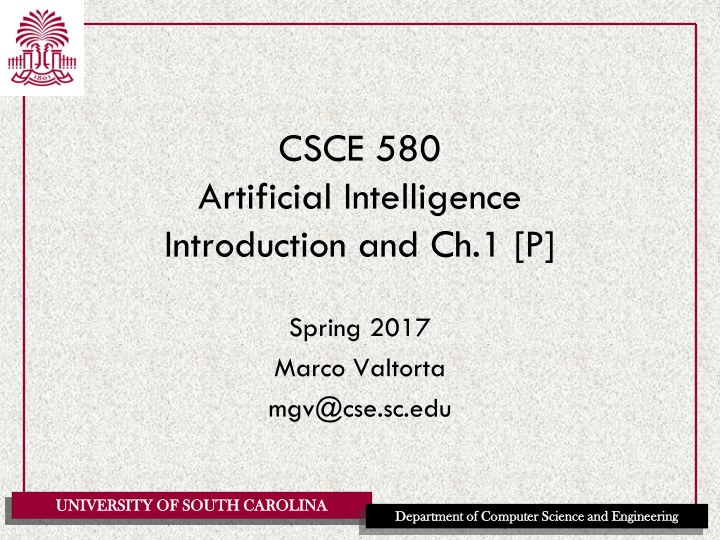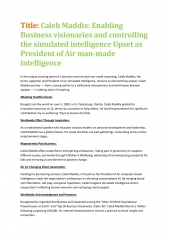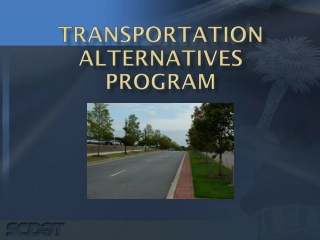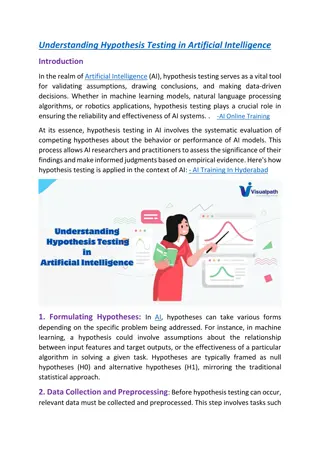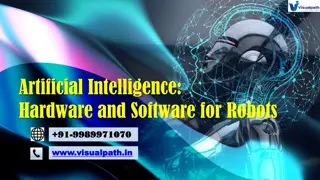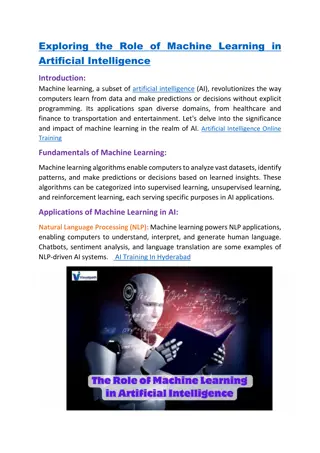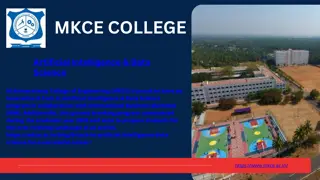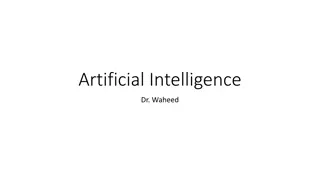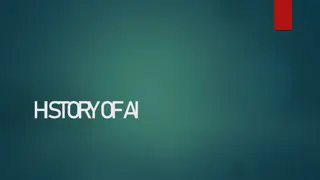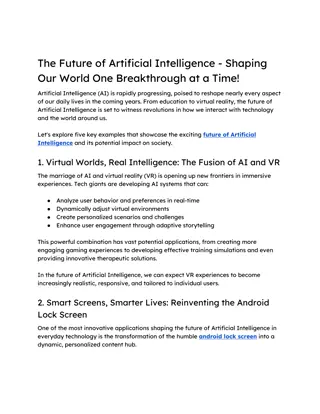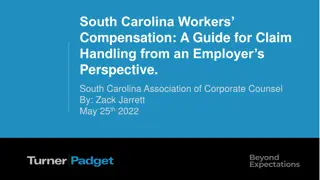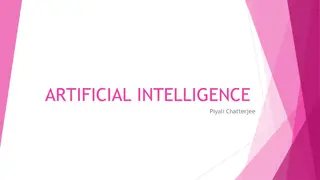Artificial Intelligence Course at University of South Carolina
This course at University of South Carolina covers topics such as heuristic problem solving, theorem proving, knowledge representation, and reasoning under uncertainty using Bayesian networks. Students will learn to write Prolog programs, formalize computational problems, and apply search algorithms. The course objectives include analyzing intelligent agents, formalizing computational problems, and representing knowledge using various methods.
Download Presentation

Please find below an Image/Link to download the presentation.
The content on the website is provided AS IS for your information and personal use only. It may not be sold, licensed, or shared on other websites without obtaining consent from the author.If you encounter any issues during the download, it is possible that the publisher has removed the file from their server.
You are allowed to download the files provided on this website for personal or commercial use, subject to the condition that they are used lawfully. All files are the property of their respective owners.
The content on the website is provided AS IS for your information and personal use only. It may not be sold, licensed, or shared on other websites without obtaining consent from the author.
E N D
Presentation Transcript
CSCE 580 Artificial Intelligence Introduction and Ch.1 [P] Spring 2017 Marco Valtorta mgv@cse.sc.edu UNIVERSITY OF SOUTH CAROLINA UNIVERSITY OF SOUTH CAROLINA Department of Computer Science and Engineering Department of Computer Science and Engineering
Catalog Description and Textbook 580 Artificial Intelligence. (3) (Prereq: CSCE 350) Heuristic problem solving, theorem proving, and knowledge representation, including the use of appropriate programming languages and tools. David Poole and Alan Mackworth. Artificial Intelligence: Foundations of Computational Agents. Cambridge University Press, 2010. [P] Supplementary materials from the authors, including an errata list, are available The full text is available online from the authors, in html format UNIVERSITY OF SOUTH CAROLINA UNIVERSITY OF SOUTH CAROLINA Department of Computer Science and Engineering Department of Computer Science and Engineering
Course Objectives Analyze and categorize software intelligent agents and the environments in which they operate Provide an argument for the notion that thinking is a computational process Write Prolog programs that support the above argument Formalize computational problems in the state-space search approach and apply search algorithms (especially A*) to solve them Represent domain knowledge using features and constraints and solve the resulting constraint processing problems Represent domain knowledge about objects using propositions and solve the resulting propositional logic problems using deduction and abduction Represent knowledge in Horn clause form and use the AILog dialect of Prolog for reasoning Reason under uncertainty using Bayesian networks UNIVERSITY OF SOUTH CAROLINA UNIVERSITY OF SOUTH CAROLINA Department of Computer Science and Engineering Department of Computer Science and Engineering
Acknowledgment The slides are based on the draft textbook and other sources, including other fine textbooks. The other textbooks I considered are: David Stuart Russell and Peter Norvig. Artificial Intelligence: A Modern Approach. Prentice-Hall, 2010 ([AIMA] or [R] or [AIMA-1], [AIMA-2], and [AIMA-3], when distinguishing editions; the first and second editions were published in 1995 and 2003, respectively.) Ivan Bratko. Prolog Programming for Artificial Intelligence, Fourth Edition. Addison-Wesley, 2011. George F. Luger. Artificial Intelligence: Structures and Strategies for Complex Problem Solving, Sixth Edition. Addison-Wesley, 2009. Richard E. Neapolitan and Xia Jiang. Contemporary Artificial Intelligence. Taylor & Francis and CRC Press, 2013. Ertel, Wolfgang. Introduction to Artificial Intelligence. Springer, 2011. UNIVERSITY OF SOUTH CAROLINA UNIVERSITY OF SOUTH CAROLINA Department of Computer Science and Engineering Department of Computer Science and Engineering
Why Study Artificial Intelligence? 1. It is exciting, in a way that many other subareas of computer science are not 2. It has a strong experimental component 3. It is a new science under development 4. It has a place for theory and practice 5. It has a different methodology 6. It leads to advances that are picked up in other areas of computer science 7. Intelligent agents are becoming ubiquitous UNIVERSITY OF SOUTH CAROLINA UNIVERSITY OF SOUTH CAROLINA Department of Computer Science and Engineering Department of Computer Science and Engineering
What is AI? Systems that think like humans The exciting new effort to make computers think machines with minds,in the full and literal sense. (Haugeland, 1985) [The automation of] activities that we associate with human thinking, activities such as decision-making, problem solving, learning (Bellman, 1978) Systems that think rationally The study of mental faculties through the use of computational models. (Charniak and McDermott, 1985) The study of the computations that make it possible to perceive, reason, and act. (Winston, 1972) Aristotle (384BC -322BC) See full size image 200px-Aristotle_Altemps_Inv8575 Richard Bellman (1920-84) Systems that act like humans The art of creating machines that perform functions that require intelligence when performed by people (Kurzweil, 1990) The study of how to make computers do things at which, at the moment, people are better (Rich and Knight, 1991) Alan Turing (1912-1954) Systems that act rationally The branch of computer science that is concerned with the automation of intelligent behavior. (Luger and Stubblefield, 1993) Computational intelligence is the study of the design of intelligent agents. (Poole et al., 1998) AI is concerned with intelligent behavior in artifacts. (Nilsson, 1998) See full size image See full size image Thomas Bayes (1702-1761) UNIVERSITY OF SOUTH CAROLINA UNIVERSITY OF SOUTH CAROLINA Department of Computer Science and Engineering Department of Computer Science and Engineering
Acting Humanly: the Turing Test Operational test for intelligent behavior: the Imitation Game In 1950, Turing predicted that by 2000, a machine might have a 30% chance of fooling a lay person for 5 minutes Anticipated all major arguments against AI in following 50 years Suggested major components of AI: knowledge, reasoning, language understanding, learning Problem: Turing test is not reproducible, constructive, or amenable to mathematical analysis UNIVERSITY OF SOUTH CAROLINA UNIVERSITY OF SOUTH CAROLINA Department of Computer Science and Engineering Department of Computer Science and Engineering
Thinking Humanly: Cognitive Science 1960s cognitive revolution": information-processing psychology replaced the prevailing orthodoxy of behaviorism Requires scientific theories of internal activities of the brain What level of abstraction? Knowledge" or circuits"? How to validate? Requires Predicting and testing behavior of human subjects (top-down), or Direct identification from neurological data (bottom-up) Both approaches (roughly, Cognitive Science and Cognitive Neuroscience) are now distinct from AI Both share with AI the following characteristic: the available theories do not explain (or engender) anything resembling human-level general intelligence Hence, all three fields share one principal direction! UNIVERSITY OF SOUTH CAROLINA UNIVERSITY OF SOUTH CAROLINA Department of Computer Science and Engineering Department of Computer Science and Engineering
Thinking Rationally: Laws of Thought Normative (or prescriptive) rather than descriptive Aristotle: what are correct arguments/thought processes? Several Greek schools developed various forms of logic: notation and rules of derivation for thoughts; may or may not have proceeded to the idea of mechanization Direct line through mathematics and philosophy to modern AI Problems: Not all intelligent behavior is mediated by logical deliberation What is the purpose of thinking? What thoughts should I have out of all the thoughts (logical or otherwise) that I could have? The Antikythera mechanism, a clockwork-like assemblage discovered in 1901 by Greek sponge divers off the Greek island of Antikythera, between Kythera and Crete. UNIVERSITY OF SOUTH CAROLINA UNIVERSITY OF SOUTH CAROLINA Department of Computer Science and Engineering Department of Computer Science and Engineering
Acting Rationally Rational behavior: doing the right thing The right thing: that which is expected to maximize goal achievement, given the available information Doesn't necessarily involve thinking (e.g., blinking reflex) but thinking should be in the service of rational action Aristotle (Nicomachean Ethics): Every art and every inquiry, and similarly every action and pursuit, is thought to aim at some good UNIVERSITY OF SOUTH CAROLINA UNIVERSITY OF SOUTH CAROLINA Department of Computer Science and Engineering Department of Computer Science and Engineering
Summary of IJCAI-83 Survey Attempt (A) 20.8 to Build (B) 12.8 Simulate (C) 17.6 Model (D) 17.6 that Machines (E) 22.4 Human (or People) (F) 60.8 Intelligent (G) 54.4 Behavior (I) 32.0 Processes (H) 24.0 by means of Computers (L) 38.4 Programs (M) 13.2 UNIVERSITY OF SOUTH CAROLINA UNIVERSITY OF SOUTH CAROLINA Department of Computer Science and Engineering Department of Computer Science and Engineering
A Detailed Definition [P] Artificial intelligence, or AI, is the synthesis and analysis of computational agents that act intelligently An agent is something that acts in an environment An agent acts intelligently when: what it does is appropriate for its circumstances and its goals it is flexible to changing environments and changing goals it learns from experience it makes appropriate choices given its perceptual and computational limitations. An agent typically cannot observe the state of the world directly; it has only a finite memory and does not have unlimited time to act. A computational agent is an agent whose decisions about its actions can be explained in terms of computation UNIVERSITY OF SOUTH CAROLINA UNIVERSITY OF SOUTH CAROLINA Department of Computer Science and Engineering Department of Computer Science and Engineering
Some Comments on the Definition A computational agent is an agent whose decisions about its actions can be explained in terms of computation The central scientific goal of artificial intelligence is to understand the principles that make intelligent behavior possible in natural or artificial systems. This is done by the analysis of natural and artificial agents formulating and testing hypotheses about what it takes to construct intelligent agents designing, building, and experimenting with computational systems that perform tasks commonly viewed as requiring intelligence The central engineering goal of artificial intelligence is the design and synthesis of useful, intelligent artifacts. We actually want to build agents that act intelligently We are interested in intelligent thought only as far as it leads to better performance UNIVERSITY OF SOUTH CAROLINA UNIVERSITY OF SOUTH CAROLINA Department of Computer Science and Engineering Department of Computer Science and Engineering
A Map of the Field This course: History, etc. Problem-solving Knowledge and reasoning Propositional logic First-order logic Knowledge representation Learning from observations (maybe) A bit of reasoning under uncertainty Other courses: Robotics (574) Bayesian networks and decision diagrams (582) Knowledge representation (780) or Knowledge systems (781) Machine learning (883) Computer graphics, text processing, visualization, image processing, pattern recognition, data mining, multiagent systems, neural information processing, computer vision, fuzzy logic; more? Blind and heuristic search Constraint satisfaction Games (maybe) UNIVERSITY OF SOUTH CAROLINA UNIVERSITY OF SOUTH CAROLINA Department of Computer Science and Engineering Department of Computer Science and Engineering
UNIVERSITY OF SOUTH CAROLINA UNIVERSITY OF SOUTH CAROLINA Department of Computer Science and Engineering Department of Computer Science and Engineering
AI Prehistory Philosophy logic, methods of reasoning mind as physical system foundations of learning, language, rationality Mathematics formal representation and proof algorithms, computation, (un)decidability, (in)tractability Probability Psychology adaptation phenomena of perception and motor control experimental techniques (psychophysics, etc.) Economics formal theory of rational decisions Linguistics knowledge representation grammar Neuroscience plastic physical substrate for mental activity Control Theory homeostatic systems, stability simple optimal agent designs UNIVERSITY OF SOUTH CAROLINA UNIVERSITY OF SOUTH CAROLINA Department of Computer Science and Engineering Department of Computer Science and Engineering
Intellectual Issues in the Early History of AI (to 1982) 1640-1945 Mechanism versus Teleology: Settled with cybernetics 1800-1920 Natural Biology versus Vitalism: Establishes the body as a machine 1870- Reason versus Emotion and Feeling #1: Separates machines from men 1870-1910 Philosophy versus Science of Mind: Separates psychology from philosophy 1900-45 Logic versus Psychology: Separates logic from psychology 1940-70 Analog versus Digital: Creates computer science 1955-65 Symbols versus Numbers: Isolates AI within computer science 1955- Symbolic versus Continuous Systems: Splits AI from cybernetics 1955-65 Problem-Solving versus Recognition #1: Splits AI from pattern recognition 1955-65 Psychology versus Neurophysiology #1: Splits AI from cybernetics 1955-65 Performance versus Learning #1: Splits AI from pattern recognition 1955-65 Serial versus Parallel #1: Coordinate with above four issues 1955-65 Heuristics Venus Algorithms: Isolates AI within computer science 1955-85 Interpretation versus Compilation #1: Isolates AI within computer science 1955- Simulation versus Engineering Analysis: Divides AI 1960- Replacing versus Helping Humans: Isolates AI 1960- Epistemology versus Heuristics: divides AI (minor), connects with philosophy 1965-80 Search versus Knowledge: Apparent paradigm shift within AI 1965-75 Power versus Generality: Shift of tasks of interest 1965- Competence versus Performance: Splits linguistics from AI and psychology 1965-75 Memory versus Processing: Splits cognitive psychology from AI 1965-75 Problem-Solving versus Recognition #2: Recognition rejoins AI via robotics 1965-75 Syntax versus Semantics: Splits lmyistics from AI 1965- Theorem-Probing versus Problem-Solving: Divides AI 1965- Engineering versus Science: divides computer science, incl. AI 1970-80 Language versus Tasks: Natural language becomes central 1970-80 Procedural versus Declarative Representation: Shift from theorem-proving 1970-80 Frames versus Atoms: Shift to holistic representations 1970- Reason versus Emotion and Feeling #2: Splits AI from philosophy of mind 1975- Toy versus Real Tasks: Shift to applications 1975- Serial versus Parallel #2: Distributed AI (Hearsay-like systems) 1975- Performance versus Learning #2: Resurgence (production systems) 1975- Psychology versus Neuroscience #2: New link to neuroscience 1980- - Serial versus Parallel #3: New attempt at neural systems 1980- Problem-solving versus Recognition #3: Return of robotics 1980- Procedural versus Declarative Representation #2: PROLOG UNIVERSITY OF SOUTH CAROLINA UNIVERSITY OF SOUTH CAROLINA Department of Computer Science and Engineering Department of Computer Science and Engineering
Programming Methodologies and Languages for AI Methodology: Run-Understand-Debug-Edit Languages: Spring 2008 survey Current use 33: Java 28: Prolog 28: Lisp or Scheme 20: C, C# or C++ 16: Python 7: Other Also see aima.cs.berkeleley.edu/code.html for AIMA-specific information Future use 38: Python 33: Java 27: Lisp or Scheme 26: Prolog 18: C, C# or C++ 13: Other UNIVERSITY OF SOUTH CAROLINA UNIVERSITY OF SOUTH CAROLINA Department of Computer Science and Engineering Department of Computer Science and Engineering
Central Hypotheses of AI A symbol is a meaningful pattern that can be manipulated (e.g., a written word, a sequence of bits). A symbol system creates, copies, modifies, and destroys symbols. Symbol-system hypothesis: A physical symbol system has the necessary and sufficient means for general intelligent action Attributed to Allan Newell (1927-1992) and Herbert Simon (1916- 2001) Church-Turing thesis: Any symbol manipulation can be carried out on a Turing machine Alonzo Church (1903-1995) Alan Turing (1912-1954) The manipulation of symbols to produce action is called reasoning UNIVERSITY OF SOUTH CAROLINA UNIVERSITY OF SOUTH CAROLINA Department of Computer Science and Engineering Department of Computer Science and Engineering
Agents and Environments UNIVERSITY OF SOUTH CAROLINA UNIVERSITY OF SOUTH CAROLINA Department of Computer Science and Engineering Department of Computer Science and Engineering
Example Agent: Robot actions: movement, grippers, speech, facial expressions,. . . observations: vision, sonar, sound, speech recognition, gesture recognition,. . . goals: deliver food, rescue people, score goals, explore,. . . past experiences: effect of steering, slipperiness, how people move,. . . prior knowledge: what is important feature, categories of objects, what a sensor tell us,. . . UNIVERSITY OF SOUTH CAROLINA UNIVERSITY OF SOUTH CAROLINA Department of Computer Science and Engineering Department of Computer Science and Engineering
Example Agent: Teacher actions: present new concept, drill, give test, explain concept,. . . observations: test results, facial expressions, errors, focus,. . . goals: particular knowledge, skills, inquisitiveness, social skills,. . . past experiences: prior test results, effects of teaching strategies, . . . prior knowledge: subject material, teaching strategies,. . . UNIVERSITY OF SOUTH CAROLINA UNIVERSITY OF SOUTH CAROLINA Department of Computer Science and Engineering Department of Computer Science and Engineering
Example agent: Medical Doctor actions: operate, test, prescribe drugs, explain instructions,. . . observations: verbal symptoms, test results, visual appearance. . . goals: remove disease, relieve pain, increase life expectancy, reduce costs,. . . past experiences: treatment outcomes, effects of drugs, test results given symptoms. . . prior knowledge: possible diseases, symptoms, possible causal relationships. . . UNIVERSITY OF SOUTH CAROLINA UNIVERSITY OF SOUTH CAROLINA Department of Computer Science and Engineering Department of Computer Science and Engineering
Example Agent: User Interface actions: present information, ask user, find another information source, filter information, interrupt,. . . observations: users request, information retrieved, user feedback, facial expressions. . . goals: present information, maximize useful information, minimize irrelevant information, privacy,. . . past experiences: effect of presentation modes, reliability of information sources,. . . prior knowledge: information sources, presentation modalities. . . UNIVERSITY OF SOUTH CAROLINA UNIVERSITY OF SOUTH CAROLINA Department of Computer Science and Engineering Department of Computer Science and Engineering
The Role of Representation Choosing a representation involves balancing conflicting objectives Different tasks require different representations Representations should be expressive (epistemologically adequate) and efficient (heuristically adequate) UNIVERSITY OF SOUTH CAROLINA UNIVERSITY OF SOUTH CAROLINA Department of Computer Science and Engineering Department of Computer Science and Engineering
Desiderata of Representations We want a representation to be rich enough to express the knowledge needed to solve the problem Epistemologically adequate as close to the problem as possible: compact, natural and maintainable amenable to efficient computation: able to express features of the problem we can exploit for computational gain Heuristically adequate learnable from data and past experiences able to trade off accuracy and computation time UNIVERSITY OF SOUTH CAROLINA UNIVERSITY OF SOUTH CAROLINA Department of Computer Science and Engineering Department of Computer Science and Engineering
Dimensions of Complexity Modularity: Flat, modular, or hierarchical Representation: Explicit states or features or objects and relations Planning Horizon: Static or finite stage or indefinite stage or infinite stage Sensing Uncertainty: Fully observable or partially observable Process Uncertainty: Deterministic or stochastic dynamics Preference Dimension: Goals or complex preferences Number of agents: Single-agent or multiple agents Learning: Knowledge is given or knowledge is learned from experience Computational Limitations: Perfect rationality or bounded rationality UNIVERSITY OF SOUTH CAROLINA UNIVERSITY OF SOUTH CAROLINA Department of Computer Science and Engineering Department of Computer Science and Engineering
Modularity You can model the system at one level of abstraction: flat [P] distinguishes flat (no organizational structure) from modular (interacting modules that can be understood on their own; hierarchical seems to be a special case of modular) You can model the system at multiple levels of abstraction: hierarchical Example: Planning a trip from here to a resort in Cancun, Mexico Flat representations are ok for simple systems, but complex biological systems, computer systems, organizations are all hierarchical A flat description is either continuous or discrete. Hierarchical reasoning is often a hybrid of continuous and discrete UNIVERSITY OF SOUTH CAROLINA UNIVERSITY OF SOUTH CAROLINA Department of Computer Science and Engineering Department of Computer Science and Engineering
Succinctness and Expressiveness of Representations Much of modern AI is about finding compact representations and exploiting that compactness for computational gains. An agent can reason in terms of: explicit states features or propositions It is often more natural to describe states in terms of features 30 binary features can represent 230 = 1,073,741,824 states. individuals and relations There is a feature for each relationship on each tuple of individuals. Often we can reason without knowing the individuals or when there are infinitely many individuals UNIVERSITY OF SOUTH CAROLINA UNIVERSITY OF SOUTH CAROLINA Department of Computer Science and Engineering Department of Computer Science and Engineering
Example: States Thermostat for a heater 2 belief (i.e., internal) states: off, heating 3 environment (i.e., external) states: cold, comfortable, hot 6 total states corresponding to the different combinations of belief and environment states Bi-metallic thermostat for buildings UNIVERSITY OF SOUTH CAROLINA UNIVERSITY OF SOUTH CAROLINA Department of Computer Science and Engineering Department of Computer Science and Engineering
Example: Features or Propositions Character recognition Input is a binary image which is a 30x30 grid of pixels Action is to determine which of the letters {a z} is drawn in the image There are 2900 different states of the image, and so 262900 different functions from the image state into the letters We cannot even represent such functions in terms of the state space Instead, we define features of the image, such as line segments, and define the function from images to characters in terms of these features A typical 7-segment LED display component, with decimal point. UNIVERSITY OF SOUTH CAROLINA UNIVERSITY OF SOUTH CAROLINA Department of Computer Science and Engineering Department of Computer Science and Engineering
Example: Relational Descriptions University Registrar Agent Propositional description: passed feature for every student-course pair that depends on the grade feature for that pair Relational description: individual students and courses relations grade and passed Define how passed depends on grade once, and apply it for each student and course. Moreover this can be done before you know of any of the individuals, and so before you know the value of any of the features covers_core_courses(St, Dept) <- core_courses(Dept, CC, MinPass) & passed_each(CC, St, MinPass). passed(St, C, MinPass) <- grade(St, C, Gr) & Gr >= MinPass. UNIVERSITY OF SOUTH CAROLINA UNIVERSITY OF SOUTH CAROLINA Department of Computer Science and Engineering Department of Computer Science and Engineering
Planning Horizon How far the agent looks into the future when deciding what to do Static: world does not change Finite stage: agent reasons about a fixed finite number of time steps Indefinite stage: agent is reasoning about finite, but not predetermined, number of time steps Infinite stage: the agent plans for going on forever (process oriented) UNIVERSITY OF SOUTH CAROLINA UNIVERSITY OF SOUTH CAROLINA Department of Computer Science and Engineering Department of Computer Science and Engineering
Uncertainty There are two dimensions for uncertainty Sensing uncertainty Process uncertainty In each dimension we can have no uncertainty: the agent knows which world is true disjunctive uncertainty: there is a set of worlds that are possible probabilistic uncertainty: a probability distribution over the worlds UNIVERSITY OF SOUTH CAROLINA UNIVERSITY OF SOUTH CAROLINA Department of Computer Science and Engineering Department of Computer Science and Engineering
Uncertainty Sensing uncertainty: Can the agent determine the state from the observations? Fully observable: the agent knows the state of the world from the observations. Partially observable: many states are possible given an observation. Process uncertainty: If the agent knew the initial state and the action, could it predict the resulting state? Deterministic dynamics: the state resulting from carrying out an action in state is determined from the action and the state Stochastic dynamics: there is uncertainty over the states resulting from executing a given action in a given state. UNIVERSITY OF SOUTH CAROLINA UNIVERSITY OF SOUTH CAROLINA Department of Computer Science and Engineering Department of Computer Science and Engineering
Preference Achievement goal is a goal to achieve. This can be a complex logical formula Complex preferences may involve tradeoffs between various desiderata, perhaps at different times ordinal only the order matters cardinal absolute values also matter Examples: coffee delivery robot, medical doctor UNIVERSITY OF SOUTH CAROLINA UNIVERSITY OF SOUTH CAROLINA Department of Computer Science and Engineering Department of Computer Science and Engineering
Number of Agents Single agent reasoning is where an agent assumes that any other agents are part of the environment Multiple agent reasoning is when an agent reasons strategically about the reasoning of other agents Agents can have their own goals: cooperative, competitive, or goals can be independent of each other UNIVERSITY OF SOUTH CAROLINA UNIVERSITY OF SOUTH CAROLINA Department of Computer Science and Engineering Department of Computer Science and Engineering
Learning Knowledge may be given learned (from data or past experience) UNIVERSITY OF SOUTH CAROLINA UNIVERSITY OF SOUTH CAROLINA Department of Computer Science and Engineering Department of Computer Science and Engineering
Bounded Rationality Solution quality as a function of time for an anytime algorithm UNIVERSITY OF SOUTH CAROLINA UNIVERSITY OF SOUTH CAROLINA Department of Computer Science and Engineering Department of Computer Science and Engineering
Examples of Representational Frameworks State-space search Classical planning Influence diagrams Decision-theoretic planning Reinforcement Learning UNIVERSITY OF SOUTH CAROLINA UNIVERSITY OF SOUTH CAROLINA Department of Computer Science and Engineering Department of Computer Science and Engineering
State-Space Search flat or hierarchical explicit states or features or objects and relations static or finite stage or indefinite stage or infinite stage fully observable or partially observable deterministic or stochastic actions goals or complex preferences single agent or multiple agents knowledge is given or learned perfect rationality or bounded rationality UNIVERSITY OF SOUTH CAROLINA UNIVERSITY OF SOUTH CAROLINA Department of Computer Science and Engineering Department of Computer Science and Engineering
Classical Planning flat or hierarchical explicit states or features or objects and relations static or finite stage or indefinite stage or infinite stage fully observable or partially observable deterministic or stochastic actions goals or complex preferences single agent or multiple agents knowledge is given or learned perfect rationality or bounded rationality UNIVERSITY OF SOUTH CAROLINA UNIVERSITY OF SOUTH CAROLINA Department of Computer Science and Engineering Department of Computer Science and Engineering
Influence Diagrams flat or hierarchical explicit states or features or objects and relations static or finite stage or indefinite stage or infinite stage fully observable or partially observable deterministic or stochastic actions goals or complex preferences single agent or multiple agents knowledge is given or learned perfect rationality or bounded rationality UNIVERSITY OF SOUTH CAROLINA UNIVERSITY OF SOUTH CAROLINA Department of Computer Science and Engineering Department of Computer Science and Engineering
Decision-Theoretic Planning flat or hierarchical explicit states or features or objects and relations static or finite stage or indefinite stage or infinite stage fully observable or partially observable deterministic or stochastic actions goals or complex preferences single agent or multiple agents knowledge is given or learned perfect rationality or bounded rationality UNIVERSITY OF SOUTH CAROLINA UNIVERSITY OF SOUTH CAROLINA Department of Computer Science and Engineering Department of Computer Science and Engineering
Reinforcement Learning flat or hierarchical explicit states or features or objects and relations static or finite stage or indefinite stage or infinite stage fully observable or partially observable deterministic or stochastic actions goals or complex preferences single agent or multiple agents knowledge is given or learned perfect rationality or bounded rationality UNIVERSITY OF SOUTH CAROLINA UNIVERSITY OF SOUTH CAROLINA Department of Computer Science and Engineering Department of Computer Science and Engineering
Comparison of Some Representations UNIVERSITY OF SOUTH CAROLINA UNIVERSITY OF SOUTH CAROLINA Department of Computer Science and Engineering Department of Computer Science and Engineering
Four Application Domains Autonomous delivery robot roams around an office environment and delivers coffee, parcels, etc. Diagnostic assistant helps a human troubleshoot problems and suggests repairs or treatments E.g., electrical problems, medical diagnosis Intelligent tutoring system teaches students in some subject area Trading agent buys goods and services on your behalf UNIVERSITY OF SOUTH CAROLINA UNIVERSITY OF SOUTH CAROLINA Department of Computer Science and Engineering Department of Computer Science and Engineering
Environment for Delivery Robot UNIVERSITY OF SOUTH CAROLINA UNIVERSITY OF SOUTH CAROLINA Department of Computer Science and Engineering Department of Computer Science and Engineering
Autonomous Delivery Robot Example inputs: Prior knowledge: its capabilities, objects it may encounter, maps. Past experience: which actions are useful and when, what objects are there, how its actions affect its position Goals: what it needs to deliver and when, tradeoffs between acting quickly and acting safely Observations: about its environment from cameras, sonar, sound, laser range finders, or keyboards Sample activities: Determine where Craig's office is. Where coffee is, etc. Find a path between locations Plan how to carry out multiple tasks Make default assumptions about where Craig is Make tradeoffs under uncertainty: should it go near the stairs? Learn from experience. Sense the world, avoid obstacles, pickup and put down coffee UNIVERSITY OF SOUTH CAROLINA UNIVERSITY OF SOUTH CAROLINA Department of Computer Science and Engineering Department of Computer Science and Engineering
Environment for Diagnostic Assistant UNIVERSITY OF SOUTH CAROLINA UNIVERSITY OF SOUTH CAROLINA Department of Computer Science and Engineering Department of Computer Science and Engineering
